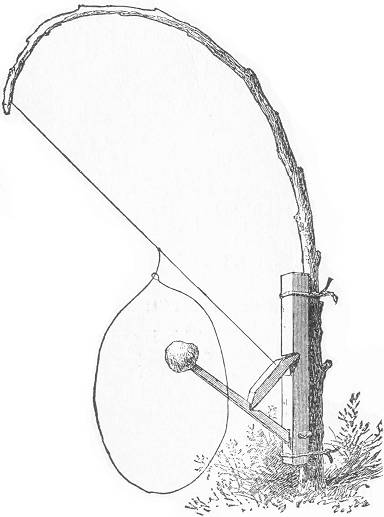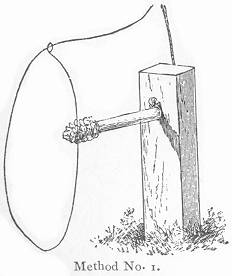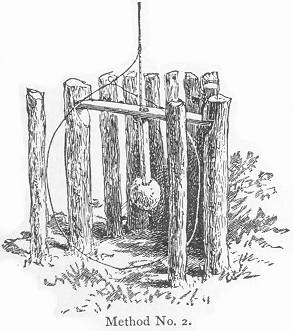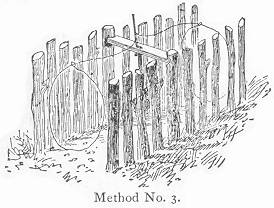Trap Post Tuesday #2
In continuation of my previous post, I will share some traps I know (and a few I don't) by transcribing from some books I have.
Portable Snare

This is simply a modification of the snare just described, but possesses decided advantages over it in many respects. In the first place, it requires little or no protection in the shape of an enclosure. It can be set in trees or in swamps, or in short in any place where an upright elastic branch can be found or adjusted. Like the foregoing, it is to be commended for its portability, fifty or sixty of the pieces making but a small parcel, and furnishing material for a score of traps. We call it the "portable snare" partly in order to distinguish it from the one just described, but chiefly because this particular variety is generally called by that name in countries where it is most used.
It is composed of three pieces, all to be cut from a shingle or thin board. Let the first be about eight inches long, and three-quarters of an inch in width. This is for the upright. An oblong mortise should be cut through this piece, one inch in length, and beginning at about an inch from the end of the stick. Three inches from the other end, and on one of the broad sides of the stick, a notch should be made, corresponding in shape to that shown in our illustration. The bait stick should be four or five inches long, one end fitting easily into the mortise, where it should be secured by a wire or smooth nail driven through so as to form a hinge, on which it will work easily. On the upper side of this stick, and two inches distant from the pivot, a notch should be cut, similar to that in the upright. The catch piece should be about two inches in length, and beveled off to a fiat edge at each end. This completes the pieces.

This is one of the most ingenious and effective devices used in the art of trapping; and the principle is so simple and universal in its application to traps in general as to become a matter of great value to all who are at all interested in the subject. There is scarcely a trap of any kind which could not be set with the knotted string and bait stick, at the expense of a little thought and ingenuity. The principle is easily understood by a look at our engraving, which probably represents the simplest twitch-up it is possible to construct. A stout wooden peg, having a hole the size of a lead pencil near the top, is driven firmly into the ground. The "knot" is made on the end of the draw-string, and passed through the hole in the peg from behind, being secured in place by the insertion of the bait stick in front. The latter should be about four inches long, and should be inserted very lightly,—merely enough to prevent the knot from slipping back. The noose should be fastened to the draw-string six or seven inches from the knot, and arranged in front of the bait at the opening of the pen, which should be constructed as previously directed. The peg should be about six inches long and the hole should be made with a 1-3 inch auger. Dozens of these pegs may be carried without inconvenience, and utilized in the same number of snares, in a very short time. We have already described the so-called "portable snare;" but, for portability, there is no noose-trap to be compared with the above. We give also a few other applications of the same principle.
In the second example, a horizontal stick is used instead of the peg, the hole being made in its center. Its ends are caught in notches in opposite sticks at the back part of the pen, and the noose arranged at the opening.

Again, by a third method, these notched sticks may be driven into the ground first, and a row of twigs continued on them on both sides, thus leaving a passageway between as represented in the illustration. A noose may then be set at each opening, with the bait in the middle; so that, at whichever side it is approached, the result is the same, besides affording a chance of securing two birds at the same time.

Pole Deadfall (Deadfalls and Snares)

The small end of the pole should be split and a small but stout stake driven firmly thru it so there will be no danger of the pole turning and "going off" of its own accord. The trap is set by placing the prop (which is only seven inches in length and half an inch thru) between the top log and the short one on the ground, to which is attached the long trigger, which is only a stick about the size of the prop, but about twice as long, the baited end of which extends back into the little pen.
The bait may consist of a piece of chicken, rabbit or any tough bit of meat so long as it is fresh and the bloodier the better. An animal on scenting the bait will reach into the trap — the top of the pen having been carefully covered over — between the logs. When the animal seizes the bait the long trigger is pulled off of the upright prop and down comes the fall, killing the animal by its weight. Skunk, coon, opossum, mink and in fact nearly all kinds of animals are easily caught in this trap. The fox is an exception, as it is rather hard to catch them in deadfalls.
The more care that you take to build the pen tight and strong, the less liable is some animal to tear it down and get bait from the outside; also if you will cover the pen with leaves, grass, sticks, etc., animals will not be so shy of the trap. The triggers are very simple, the long one being placed on top of the upright, or short one. The long triggers should have a short prong left or a nail driven in it to prevent the game from getting the bait off too easy. If you find it hard to get saplings the right size for a fall, and are too light, they can be weighted with a pole laid on the "fall."